Components of Attitude
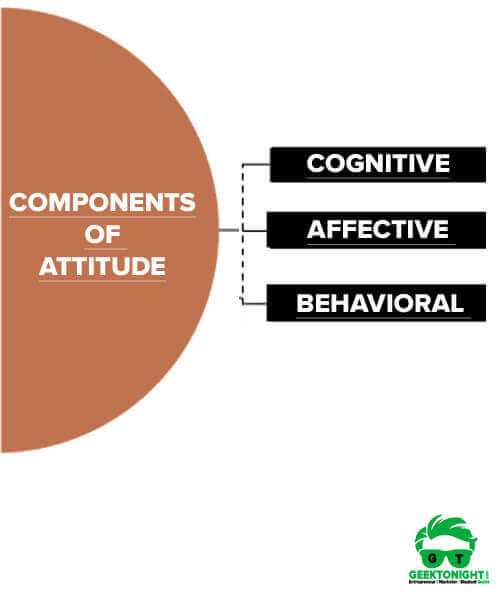 Components of Attitude
Components of Attitude
Cognitive component
Beliefs are the cognitive components of consumer attitude. Cognitive component of attitude is associated with the value statement. It consists of values, belief, ideas and other information that a person may have faith in.
Positive brand associations enhance brand equity and are achieved through a number of positioning strategies. Through brand associations, marketers establish and influence favorable beliefs about a brand and unfavorable beliefs about competitors.
Example: Quality of sincere hard is a faith or value statement that a manager may have.
Affective component
Affective is the emotive component of consumer attitude. Affective component of attitude is associated with individual feelings about another person, which may be positive, neutral or negative.
Three research models describe the determinants of affective response.
- Functional theory of attitude explains that consumers buy as a result of one of four psychological functions: adjustment, ego defense, value expression, and application of prior knowledge.
- Fishbein model relates consumer beliefs and evaluations to affective response: if beliefs are strong and desirable, affective responses are positive.
- Belief importance model analyses affective responses across competing brands.
Example: I don’t like Sam because he is not honest, or I like Sam because he is sincere. It is an expression of feelings about a person, object or a situation.
Behavioral component
Intention is the behavioral component of consumer attitude. Behavioral component of attitude is associated with the impact of various condition or situations that lead to person behavior based on cognitive and affective components.
Two research models demonstrate the relationship between intention to purchase and actual purchase and consumption.
- The theories of reasoned action explain purchasing behavior as a direct result of intention, influenced by attitude toward purchase and by subjective norms.
- The theory of trying to consume explains actual consumption behavior of purchasers. It provides insight into the establishment and maintenance of long-term relationship with consumers.
Example: I don’t like Sam because he is not honest is an affective component, I, therefore, would like to disassociate myself with him, is a behavioural component and therefore I would avoid Sam.
Cognitive and affective components are bases for such behaviour. Former two components cannot be seen, only the behaviour component can be seen. Former is important because it is a base for the formation of attitude.
Also Read: Vroom’s Expectancy Theory of Motivation
Characteristics of Attitude
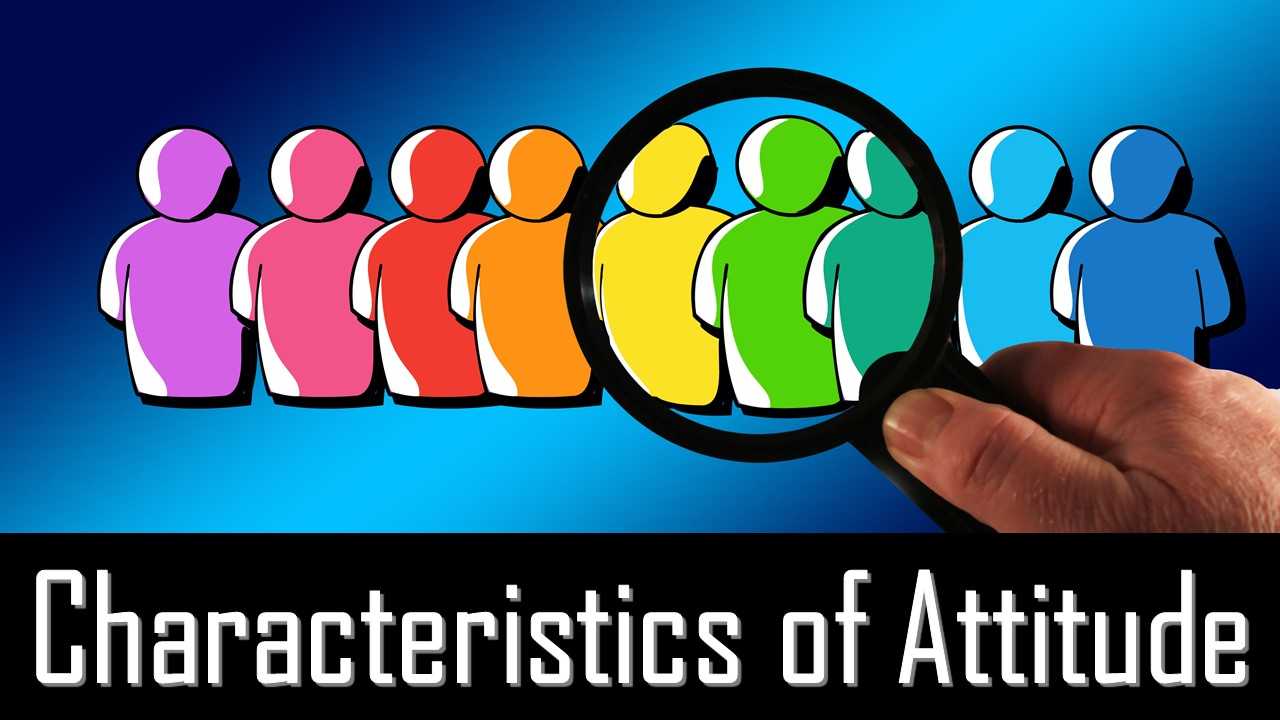
Attitude can be described as a tendency to react positively or negatively to a person or circumstances.
Thus the two main elements of attitude are this tendency or predisposition and the direction of this predisposition.
It has been defined as a mental state of readiness, organized through experience, which exerts a directive or dynamic influence on the responses.
These can also be explicit and implicit.
Explicit attitudes are those that we are consciously aware of and that clearly influences our behaviors and beliefs. Implicit attitudes are unconscious but still affect our beliefs and behaviors.
Psychologists Thomas, which imposes limits as a level attitude trend, is positive and negative, associated with psychology.
Object psychology here includes symbols, words, slogans, people, institutions, ideas, etc.
Characteristics of Attitude are;
- Attitudes are the complex combination of things we call personality, beliefs, values, behaviors, and motivations.
- It can fall anywhere along a continuum from very favorable to very unfavorable.
- All people, irrespective of their status or intelligence, hold attitudes.
- An attitude exists in every person’s mind. It helps to define our identity, guide our actions, and influence how we judge people.
- Although the feeling and belief components of attitude are internal to a person, we can view a person’s attitude from their resulting behavior.
- Attitude helps us define how we see situations and define how we behave toward the situation or object.
- It provides us with internal cognitions or beliefs and thoughts about people and objects.
- It can also be explicit and implicit. Explicit attitude is those that we are consciously aware of an implicit attitude is unconscious, but still, affect our behaviors.
- Attitudes cause us to behave in a particular way toward an object or person.
- An attitude is a summary of a person’s experience; thus, an attitude is grounded in direct experience predicts future behavior more accurately.
- It includes certain aspects of personality as interests, appreciation, and social conduct.
- It indicates the total of a man’s inclinations and feelings.
- An attitude is a point of view, substantiated or otherwise, true or false, which one holds towards an idea, object, or person.
- It has aspects such as direction, intensity, generality, or specificity.
- It refers to one’s readiness for doing Work.
- It may be positive or negative and may be affected by age, position, and education.
Attitude may be defined as a feeling or disposition to favor or be against objects, persons, and situations.
It is a well-defined object of reference. It may be defined as ‘an enduring predisposition or readiness to react or behave in a particular manner to a given object or situation, idea, material, or person.’
It describes and evaluates an object or a situation, with each belief having a cognitive effect and behavioral components.
Each of these beliefs is a predisposition that results in some preferential response towards the object or the situation.
Actually, it is frequently used in describing people and explaining their behavior.
For example:-
“I like her attitude,” “He has a good attitude,” etc. Actually, it is characterized by the tendency to feel and behave in a particular way toward some object.
Definition of Attitude
Attitude is the manner, disposition, feeling, and position about a person or thing, tendency, or orientation, especially in mind.
According to Gordon Allport, “An attitude is a mental and neural state of readiness, organized through experience, exerting a directive or dynamic influence upon the individual’s response to all objects and situations with which it is related.”
Frank Freeman said, “An attitude is a dispositional readiness to respond to certain institutions, persons or objects in a consistent manner which has been learned and has become one’s typical mode of response.”
Thurstone said, “An attitude denotes the total of man’s inclinations and feelings, prejudice or bias, preconceived notions, ideas, fears, threats, and other any specific topic.”
Anastasi defined attitude as “A tendency to react favorably or unfavorably towards a designated class of stimuli, such as a national or racial group, a custom or an institution.”
According to N.L. Munn, “Attitudes are learned predispositions towards aspects of our environment. They may be positively or negatively directed towards certain people, service, or institution.”
“Attitudes are an ‘individual’s enduring favorable or unfavorable evaluations, emotional feelings, and action tendencies toward some object or idea.” — David Krech, Richard S. Crutchfield, and Egerton L. Ballackey.
“Attitude can be described as a learned predisposition to respond in a consistently favorable or unfavorable manner for a given object.” — Martin Fishbein and Icek Ajzen.
“An attitude is a relatively enduring organization of beliefs around an object or situation predisposing one to respond in some preferential manner.” — Milton Rokeach.
Attitude Strength
Attitude Strength
The strength with which an attitude is held is often a good predictor of behavior. The stronger the attitude the more likely it should affect behavior. Attitude strength involves:
Importance / personal relevance refers to how significant the attitude is for the person and relates to self-interest, social identification and value.
If an attitude has a high self-interest for a person (i.e. it is held by a group the person is a member of or would like to be a member of, and is related to a person’s values), it is going to be extremely important.
As a consequence, the attitude will have a very strong influence upon a person’s behavior. By contrast, an attitude will not be important to a person if it does not relate in any way to their life.
The knowledge aspect of attitude strength covers how much a person knows about the attitude object. People are generally more knowledgeable about topics that interest them and are likely to hold strong attitudes (positive or negative) as a consequence.
Attitudes based on direct experience are more strongly held and influence behavior more than attitudes formed indirectly (for example, through hear-say, reading or watching television).
Definition of Attitude
Generally, attitude is a behavior a person adopts toward other people, things, incidents, or happenings. In literature, the term “attitude” can be referred as perspective or tone of the writer he adopts in a certain work.
It is the way a writer develops his characters, describes his stories and designs his narratives. His attitude explains the real nature of the characters and the story. He makes use of an appropriate attitude to provide an in-depth insight into a character’s personality. The attitude of a writer can be serious as well as humorous. In certain cases, the attitude can be critical or witty. It is through the attitude readers come to know the feelings of a writer regarding his topic, subject or belief.
As written works have a central idea or theme for the audiences, different writers approach themes with different attitudes and tone, which are developed by the choice of words and style. The two examples given below discuss the same subject matter; however, the first demonstrates an informal and casual attitude, while the second example discusses the same theme in a highly formal attitude.
- “I want to ask the authorities what is the big deal? Why do they not control the epidemic? It is eating up lives like a monster.”
- “I want to draw the attention of the concerned authorities toward damage caused by the epidemic. If steps are not taken to curb it, it will further injure our community”
Credits
New World Encyclopedia writers and editors rewrote and completed the Wikipedia article
in accordance with New World Encyclopedia standards. This article abides by terms of the Creative Commons CC-by-sa 3.0 License (CC-by-sa), which may be used and disseminated with proper attribution. Credit is due under the terms of this license that can reference both the New World Encyclopedia contributors and the selfless volunteer contributors of the Wikimedia Foundation. To cite this article click here for a list of acceptable citing formats.The history of earlier contributions by wikipedians is accessible to researchers here:
- Attitude_(psychology) history
- Balance_theory history
- Elaboration_Likelihood_Model history
- Self-perception_theory history
- Social_judgment_theory history
The history of this article since it was imported to New World Encyclopedia:
History of «Attitude»
Note: Some restrictions may apply to use of individual images which are separately licensed.
Examples of Attitude in Literature
Attitude plays a significant role in literature, because it bridges the gap between the reader and the writer.
Example #1: The Catcher in the Rye (By J. D. Salinger)
This is a selection of dialogues from J.D. Salinger’s The Catcher in the Rye, all of which are uttered by Holden Caulfield. It is easy to understand the nature and real personality of the character through these statements. Most of the remarks are quite sarcastic, as Holden talks about real things in criticizing manner. It is not only a way to know the personality of the character, but it opens a window to the writer’s viewpoint of real life objects. In fact, the characters are the mouthpieces of the writer’s attitude and thinking. That is why this shows the attitude of D. J. Salinger too.
Example #2: The School (By Donald Barthelme)
A fine example of attitude is presented in this passage. This passage is from Donald Barthelme’s short story The School. The author uses certain adjectives like “dead” and “depressing,” which develop a gloomy attitude toward the story. Trees symbolize life in these lines, and their death, which has been unexpected, colors the passage with gloomy and negative shades. This is the attitude of the writer as well.
Example #3: The Road Not Taken (By Arthur Miller)
The influence of attitude can easily be perceived in the last stanza of The Road Not Taken, a poem composed by Robert Frost. When the poet, Robert Frost, talks about his past, he mentions it with a “sigh.” The use of the sigh draws a picture of nostalgia for the past. The poet’s attitude reveals that the speaker was compelled to make a choice that was very difficult for him, but now he is nostalgic about it.
Functions of Attitude
Four important which are crucial in organizational behavior viewpoint are:
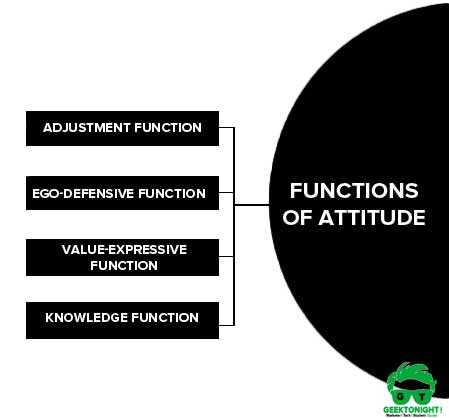 Functions of Attitude
Functions of Attitude
Adjustment Function
Attitudes often help individuals to adjust to their work environment.
Consumers hold certain brand attitudes partly because of the brand utility. If a product has helped us in the past even in a small way, our attitude towards it tends to be favorable. One way of changing attitude in favor of a product is by showing people that it can solve utilitarian goals. They may not have considered some advertisement which stresses the utilitarian benefits of a product.
Example: Well-treated employees tend to develop a positive attitude towards their management or job.
Ego-Defensive Function
Consumers want to protect their self concept from inner feelings of doubt. Cosmetic and personal hygiene products, by acknowledging this need, increase their relevance to the consumer and have the possibility of a favorable attitude by offering reassurance to the consumers self concept.
Example: Older faculty might feel somewhat threatened by a young and new faculty member who is full of fresh ideas and enthusiasm
Value-Expressive Function
Attitudes are one expression of general values, lifestyles, and outlook. If a consumer segment generally holds a positive attitude towards being in a fashion segment, consumer may treat high fashion clothing and accessories as symbols of that lifestyle.
Example, a manager who values honest and sincere work will be more vocal against an employee who is having a very casual approach towards work.
Knowledge Function
Attitudes provide frames of reference or standard that allow individuals to understand and perceive the world around him. Individuals have a strong need to know and understand the people and things with whom they come in contact, especially if they think they might influence their behavior.
Example, If a student has a strong negative attitude towards the college, whatever the college does, the student will be perceived as something ‘bad’ and as actually against them.
Also Read: What is Motivation? |
Attitudes and Beliefs

An attitude is a relatively enduring organization of beliefs, feelings, and behavioral tendencies towards socially significant objects, groups, events, or symbols.
It is a learned predisposition to respond in a consistently favorable or unfavorable manner for a given object.
It is an expression of evaluation toward a person, place, thing, or event. It will always have a positive and negative element and tend to behave in a certain way.
Attitudes are formed primarily based on underlying values and beliefs.
While attitude is the predisposition to act in a particular way towards an object or situation, opinion is the expression of an individual’s judgment about a particular set of facts.
It is an evaluation of the circumstances presented to an individual.
Beliefs are acquired through real experiences, but the original experience related to a particular belief is mostly forgotten.
It affects the quality of our work and relationships because we experience what we believe, and it is not based on reality. They are an important part of our identity.
They may be religious, cultural, or moral.
Beliefs reflect who we are and how we live our lives. It is composed of multiple factors tending to family, society, and the structure of life. It is the trust that something is true and good without any doubt.
It is an internal feeling that something is true, even though that belief may be unproven or irrational.
I believe that walking under a ladder brings bad luck.
Attitude Formation
The question often arises, ‘how are the attitudes and subsequent behaviors formed?’ While attitudes are basically learned over the years, some inherited characteristics do affect such attitudes
Some of the learned characteristics responsible for are:
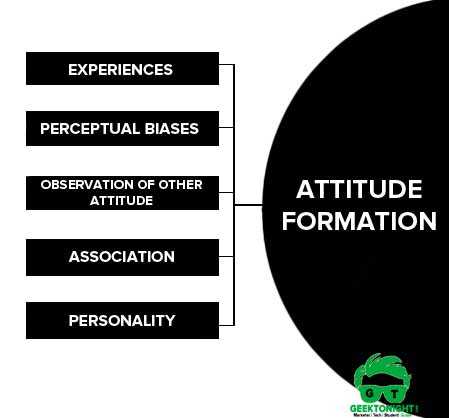 Attitude Formation
Attitude Formation
Experiences
Our personal experiences with people and situations develop our attitude towards such persons and situations.Through job experience, people develop attitudes towards working conditions, salaries, supervision, group dynamics and so on.
Perceptual biases
Perception is the result of a complex interaction of various senses such as feelings, seeing, hearing and so on and plays an important part in our attitude and behavioural formation.For example, if a manager perceives a subordinate’s ability as limited, he will give him limited responsibility. Similarly, we lose many good friends due to our changed perception about them.
Observation of other person attitude
When we like someone, we try to emulate that person’s attitude. For example, when we are impressed by someone keeping calm under stressful circumstances and we appreciate such calmness, we might try to do the same.
Association
Our association with the group we belong to strongly influences our attitude. Our close association with a group would encourage us to be consistent with the attitude of the group.
Personality
Personality is a set of traits and characteristics, habit patterns and conditioned responses to certain stimuli that formulate the impression that a person makes upon others and this impression is a function of a person’s attitude.
Attitudes vs. Behavior
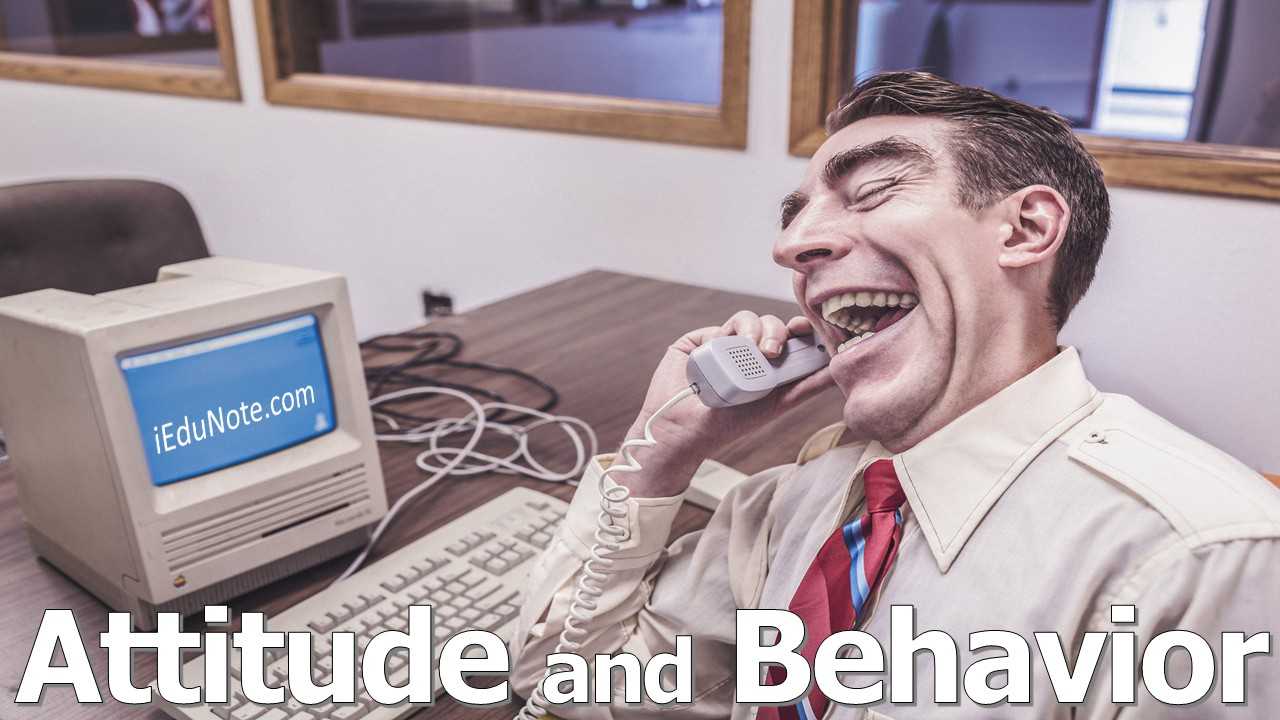
Attitude refers to feelings, beliefs, and behavior predispositions directed towards people, groups, ideas, or objects.
It influences the behavior of the individuals. It decides how to act or behave in a particular situation.
Attitude is a kind of habit. It is the usual way of doing things.
Everything in an organization will get better if the attitude of everyone gets better. Successes and failures in life depend upon the attitude of the individuals.
If attitudes are positive, then human relations will be positive. It is internal and challenging to change.
Behavior is the way a person responds to his attitude. This response is either positive or negative, depending on how that views his position.
For example, an employee who disagrees?
His supervisor may ignore office protocol.
Besides, an employee who dislikes another coworker or has little respect for a coworker may display this attitude by speaking harshly to this individual.
Behavior can be influenced by factors beyond attitude, including preconceptions about self and others, monetary factors, social influences, and convenience.
It is the actions or reactions of a person or animal in response to external or internal stimuli. It indicates how something functions or operates.
Key Differences Between Attitude and Behavior
The difference between attitude and behavior can be drawn clearly on the following grounds:
- Attitude is defined as a person’s mental tendency, which is responsible for the way he thinks or feels for someone or something. Behavior implies the actions, moves, conduct or functions of an individual or group towards other persons.
- A person’s attitude is mainly based on the experiences gained by him during the course of his life and observations. On the other hand, the behavior of a person relies on the situation.
- Attitude is a person’s inner thoughts and feelings. As opposed to, behavior expresses a person’s attitude.
- The way of thinking or feeling is reflected by a person’s attitude. On the contrary, a person’s conduct is reflected by his behavior.
- Attitude is defined by the way we perceive things whereas behavior is ruled by social norms.
- Attitude is a human trait but behavior is an inborn attribute.
Attitudes and prejudices in the workplace
In our age of globalization the understanding and explanation of attitudes and prejudices has become crucial. Prejudice is a particular form of attitude. It is a negative evaluation of a group of people defined by such characteristics as social class, race, ethnicity, religion, gender, socio-economic status, sexual orientation, and so forth.
An important component of prejudice is the existence of stereotypes—reduced and often distorted beliefs about the characteristics possessed by members of a particular group. Stereotypes are examples of the heuristics that guide us through many of our social encounters. One reason we tend to view outgroup members negatively is our use of the available heuristic: Negative behaviors are often more vivid than positive ones, and outgroup members are more noticeable. Thus, when outgroup members commit an illegal act, we are more likely to notice it and to remember it. We then incorrectly conclude that the behavior is a characteristic of the outgroup as a whole. People also tend to apply the illusion of outgroup homogeneity. Although they realize that their own group contains members who are very different from each other, they tend to view members of other groups as rather similar. Obviously, this tendency contributes to the formation of stereotypes.
Prejudices often lead to discrimination—actual behaviors injurious to the members of the group. Intergroup conflict, such as war or gang violence, often has at its core ethnocentrism, or the belief that one’s own group is superior to or more deserving than another group.
Attitude Formation
Several factors can influence how and why attitudes form, including:
Experience
Attitudes form directly as a result of experience. They may emerge due to direct personal experience, or they may result from observation.
Social Factors
Social roles and social norms can have a strong influence on attitudes. Social roles relate to how people are expected to behave in a particular role or context. Social norms involve society’s rules for what behaviors are considered appropriate.
Learning
Attitudes can be learned in a variety of ways. Consider how advertisers use classical conditioning to influence your attitude toward a particular product. In a television commercial, you see young, beautiful people having fun on a tropical beach while enjoying a sports drink. This attractive and appealing imagery causes you to develop a positive association with this particular beverage.
Conditioning
Operant conditioning can also be used to influence how attitudes develop. Imagine a young man who has just started smoking. Whenever he lights up a cigarette, people complain, chastise him, and ask him to leave their vicinity. This negative feedback from those around him eventually causes him to develop an unfavorable opinion of smoking and he decides to give up the habit.
Observation
Finally, people also learn attitudes by observing people around them. When someone you admire greatly espouses a particular attitude, you are more likely to develop the same beliefs. For example, children spend a great deal of time observing the attitudes of their parents and usually begin to demonstrate similar outlooks.
Recap
Attitudes can form through direct experience, social influence, formal education, conditioning processes, and observation.
ReferencesISBN links support NWE through referral fees
- Bem, D.J. 1967. «Self-perception: An alternative interpretation of cognitive dissonance phenomena» in Psychological Review 74: 183–200.
- Bem, D.J. 1972. «Self-perception theory» in L. Berkowitz (Ed.), Advances in Experimental Social psychology 6: 1-62. New York: Academic Press. Full text (PDF). Summary. Retrieved August 1, 2007.
- Boring, E.G. 1950. A history of experimental psychology, 2nd ed. Englewood Cliffs, NJ: Prentice Hall. ISBN 0133900398
- Brennan, J.F. 1986. History and systems of psychology. Englewood Cliffs, NJ: Prentice-Hall, Inc. ISBN 0133922189
- Eagly, A.H., & S. Chaiken. 1993. Psychology of Attitudes. Fort Worth, TX: Harcourt, Brace, Jovanovich. ISBN 0155000977
- Festinger, L.A. 1957. Theory of Cognitive Dissonance. Stanford: Stanford University Press. ISBN 0804701318
- Festinger, L., and J.M. Carlsmith. 1959. «Cognitive consequences of forced compliance» in Journal of Abnormal and Social Psychology 58: 203-210.
- Fiske, S.T. 1993. «Controlling other people: The impact of power on stereotyping» in American Psychologist 48: 621-628.
- Heider, F. 1958. The Psychology of Interpersonal Relations. New York: John Wiley and Sons. ISBN 0898592828
- Hovland, C.I., and W. Weiss. 1951. «The influence of source credibility on communication effectiveness» in Public Opinion Quarterly 15: 635-650.
- Leahey, T.H. 1991. A History of Modern Psychology, 3rd edition. Englewood Cliff, NJ: Prentice Hall. 2000. ISBN 0130175730
- Petty, R.E., P. Briñol, & Z.L. Tormala. 2002. «Thought confidence as a determinant of persuasion: The self-validation hypothesis» in Journal of Personality & Social Psychology 82: 722-741.
- Petty, R.E., & J.T. Cacioppo. 1981. Attitudes and persuasion: Classic and contemporary approaches. Dubuque, IA: Wm.C. Brown. ISBN 081333005X
- Petty, R.E., & J.T. Cacioppo. 1986. Communication and persuasion: Central and peripheral routes to attitude change. New York: Springer-Verlag. ISBN 0387963448
- Petty, R.E., & D.T. Wegener. 1999. «The Elaboration likelihood model: Current status and controversies» in Dual Process Theories in Social Psychology. New York: Guilford Press, 41-72.
- Rajecki, D.J. 1989. Attitudes, 2nd edition, Sunderland, MA: Sinauer Associates.
- Sivacek, J., and W.D. Grano. 1977. «Vested interest as a moderator of attitude-behavior consistency» in Journal of Personality and Social Psycholgy 43: 537-544.
Factors Influencing Attitudes

By attitudes, we mean the beliefs, feelings, and action tendencies of individuals or individuals towards objects, ideas, and people.
Attitudes involve some knowledge of a situation.
However, the essential aspect of the attitude is found in the fact that some characteristic feeling or emotion is experienced and, as we would accordingly expect, some definite tendency to action is associated.
Subjectively, then, the important factor is the feeling or emotion.
Many different factors can influence how and why attitudes form. These are-
- Social Factors.
- Direct Instruction.
- Family.
- Prejudices.
- Personal Experience.
- Media.
- Educational and Religious Institutions.
- Physical Factors.
- Economic Status and Occupations.
Learn more about factors influencing attitudes.
Overview of Attitude
To understand the meaning of attitudes, it can be helpful to look at a few different examples:
- Your opinion on the death penalty
- Your opinion about which political party does a better job of running the country
- Whether prayer be allowed in schools
- Whether violence on television be regulated
Chances are that you probably have fairly strong opinions on these and similar questions. You’ve developed attitudes about such issues, and these attitudes influence your beliefs as well as your behavior. Attitudes are an important topic of study within the field of social psychology. But what exactly is an attitude? How does it develop?
How Psychologists Define Attitudes
Psychologists define attitudes as a learned tendency to evaluate things in a certain way. This can include evaluations of people, issues, objects, or events. Such evaluations are often positive or negative, but they can also be uncertain at times.
For example, you might have mixed feelings about a particular person or issue. Researchers also suggest that there are several different characteristics that make up attitudes. The components of attitudes are sometimes referred to as CAB or the ABC’s of attitude.
3 Components of Attitude
- Cognitive Component: Your thoughts and beliefs about the subject
- Affective Component: How the object, person, issue, or event makes you feel
- Behavioral Component: How attitude influences your behavior
Attitudes can also be explicit and implicit. Explicit attitudes are those that we are consciously aware of and that clearly influence our behaviors and beliefs. Implicit attitudes are unconscious but still have an effect on our beliefs and behaviors.
Barriers to Change Attitudes
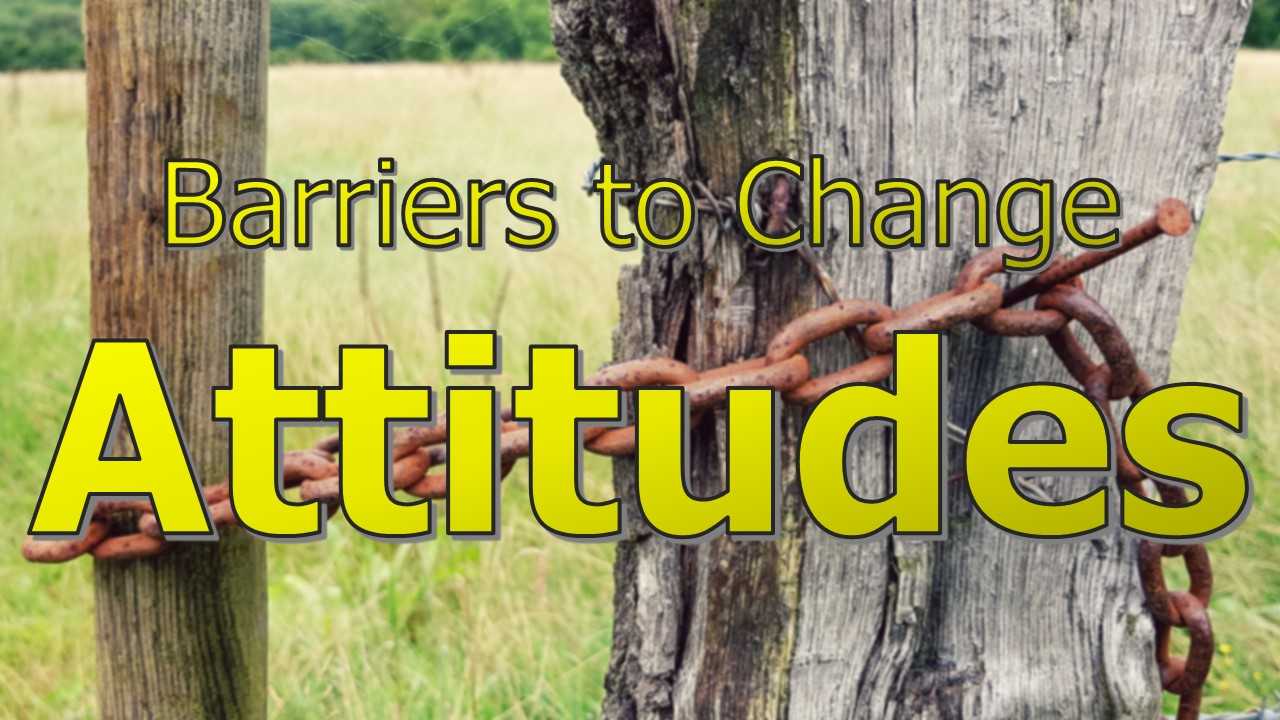
Employees’ attitudes can be changed, and sometimes it is in the best interests of management to try to do so.
For example, if employees believe that their employer does not look after their welfare, the management should try to change employees’ attitudes and develop a more positive attitude towards them.
However, the process of changing the attitude is not always easy.
Actually, the barriers are the limits that prevent the organization from achieving its predetermined goals.
So every organization should be aware of these and should take corrective actions.
Barriers to Change Attitudes are;
- Prior Commitment.
- Insufficient Information.
- Balance and Consistency.
- Lack of Resources.
- Improper Reward System.
- Resistance to Change.
Prior Commitment
When people feel a commitment towards a particular course of action that has already been agreed upon, it becomes difficult for them to change or accept the new ways of functioning.
Insufficient Information
It also acts as a major barrier to change attitudes. Sometimes people do not see why they should change their attitude due to the unavailability of adequate information.
Sometimes people do not see why they should change their attitude due to the unavailability of adequate information.
Balance and Consistency
Another obstacle to a change of attitude is the attitude theory of balance and consistency.
Human beings prefer their attitudes about people and things to be in line with their behaviors towards each other and objects.
Lack of Resources
If plans become excessively ambitious, they can sometimes be obstructed by the lack of resources on a company or organization.
So, in this case, if the organization wants to change the employees’ attitude towards the new plan, sometimes it becomes impossible for the lack of resources to achieve this.
Improper Reward System
Sometimes, an improper reward system acts as a barrier to change attitude.
If an organization places too much emphasis on short-term performance and results, managers may ignore longer-term issues as they set goals and formulate plans to achieve higher profits in the short term.
If this reward system is introduced in the organization, employees are not motivated to change their attitude.
Resistance to Change
Another barrier is resistance to change.
Basically, change is a continuous process within and outside the organization to achieve the set goal.
When the authority changes a plan of the organization, the employees have to change themselves.
But some of them do not like this. If their attitude regarding the change of plan cannot be changed, the organization will not be successful.


































